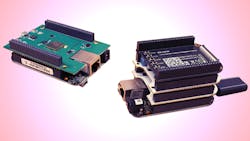This file type includes high resolution graphics and schematics when applicable.
A few years ago Gumstix came out with Geppetto, a web-based designer and build-to-order system. I was contemplating giving it an Electronic Design Best of award, but at the time it was limited to the company’s own ARM-based COM modules. This year, Gumstix turned the corner and started supporting third-party platforms like the popular BeagleBone, as well as standalone microcontrollers.
The web-based design tool is the key (Figs. 1 and 2). It is similar to the drag-and-drop interface used by other printed circuit board (PCB) design tools for placement, albeit with two major differences. First, there is no routing involved. That part of the PCB design is automatic and hidden from the designer. The other difference is the logical linking between chips and connectors. It is only possible to connect a USB interface on a COM module or processor to a matching USB connector or header. Those can be placed anywhere on the board.
A working board can be designed in an afternoon. Production boards can be delivered within three weeks. This is not a blank PCB: These boards have all the components installed. There is a fixed set-up charge of $2,000 and the price of a board is available as the design progresses. Each component also has a price so a designer can see what it will cost to add a new item.
Components change from red to yellow to green as they are connected. For example, a microcontroller or COM module requires power. Some may also need boot memory and an external reset. The system even tracks power sources and utilization so one cannot skimp on a voltage regulator.
Most systems are designed to run Linux. The system also generates files that work with the Yocto Project tools, so the proper drivers are configured and ready to work with the customized design.
Geppetto has many limitations. It cannot be extended except by Gumstix, so a board can only include components in Geppetto’s menu. Right now there is only one GPS and one nine-axis sensor to choose from. There are a number of LCD displays, but only one gigabit Ethernet connector. Still, Gumstix continues to expand the menu of components.
Geppetto costs nothing to use, so it is easy to determine whether the system can complete a design to meet your needs. The set-up charge is for the initial run, and additional boards can be ordered as needed.
Many engineering design companies can help turn just about any design into a product, but it will usually take a bit longer and cost a bit more than using Geppetto. The advantage gained is the ability to incorporate almost anything into the design. Custom designs make sense when building a million boards, but the dynamics changes as the number of boards and complexity of design is reduced.
This file type includes high resolution graphics and schematics when applicable.
About the Author
William G. Wong
Senior Content Director - Electronic Design and Microwaves & RF
I am Editor of Electronic Design focusing on embedded, software, and systems. As Senior Content Director, I also manage Microwaves & RF and I work with a great team of editors to provide engineers, programmers, developers and technical managers with interesting and useful articles and videos on a regular basis. Check out our free newsletters to see the latest content.
You can send press releases for new products for possible coverage on the website. I am also interested in receiving contributed articles for publishing on our website. Use our template and send to me along with a signed release form.
Check out my blog, AltEmbedded on Electronic Design, as well as his latest articles on this site that are listed below.
You can visit my social media via these links:
- AltEmbedded on Electronic Design
- Bill Wong on Facebook
- @AltEmbedded on Twitter
- Bill Wong on LinkedIn
I earned a Bachelor of Electrical Engineering at the Georgia Institute of Technology and a Masters in Computer Science from Rutgers University. I still do a bit of programming using everything from C and C++ to Rust and Ada/SPARK. I do a bit of PHP programming for Drupal websites. I have posted a few Drupal modules.
I still get a hand on software and electronic hardware. Some of this can be found on our Kit Close-Up video series. You can also see me on many of our TechXchange Talk videos. I am interested in a range of projects from robotics to artificial intelligence.




